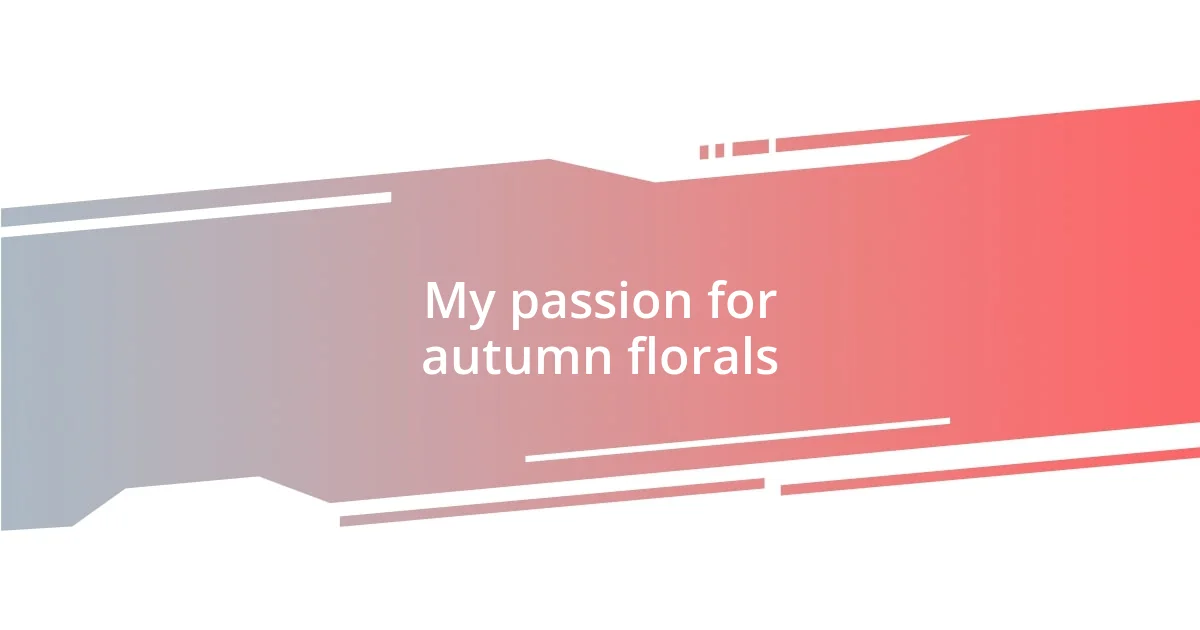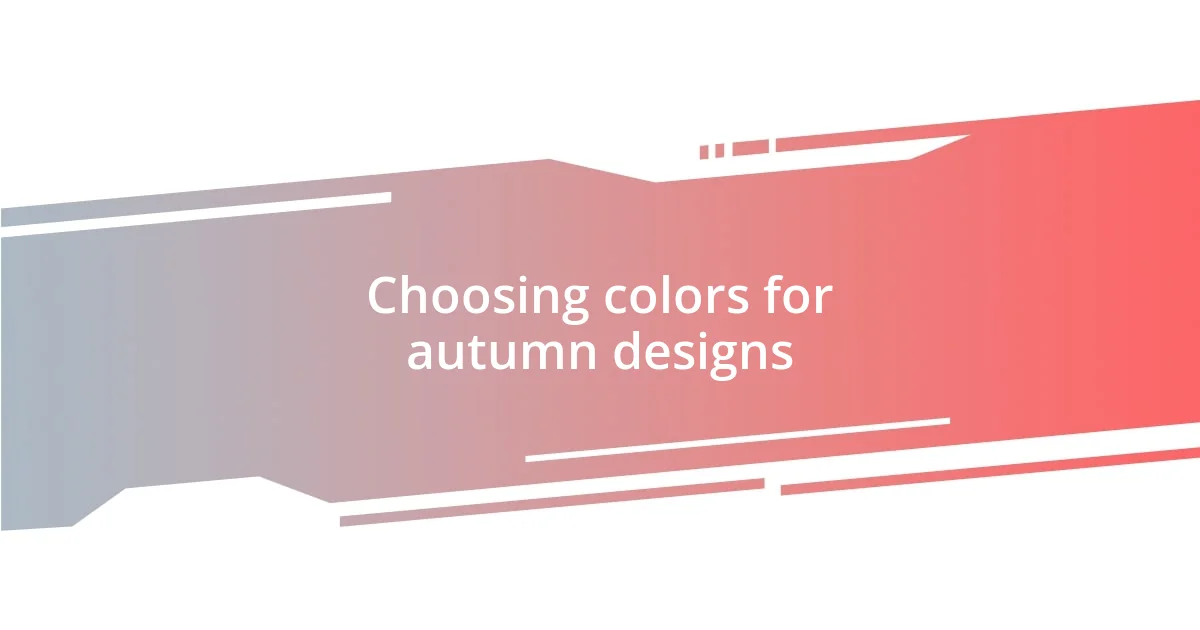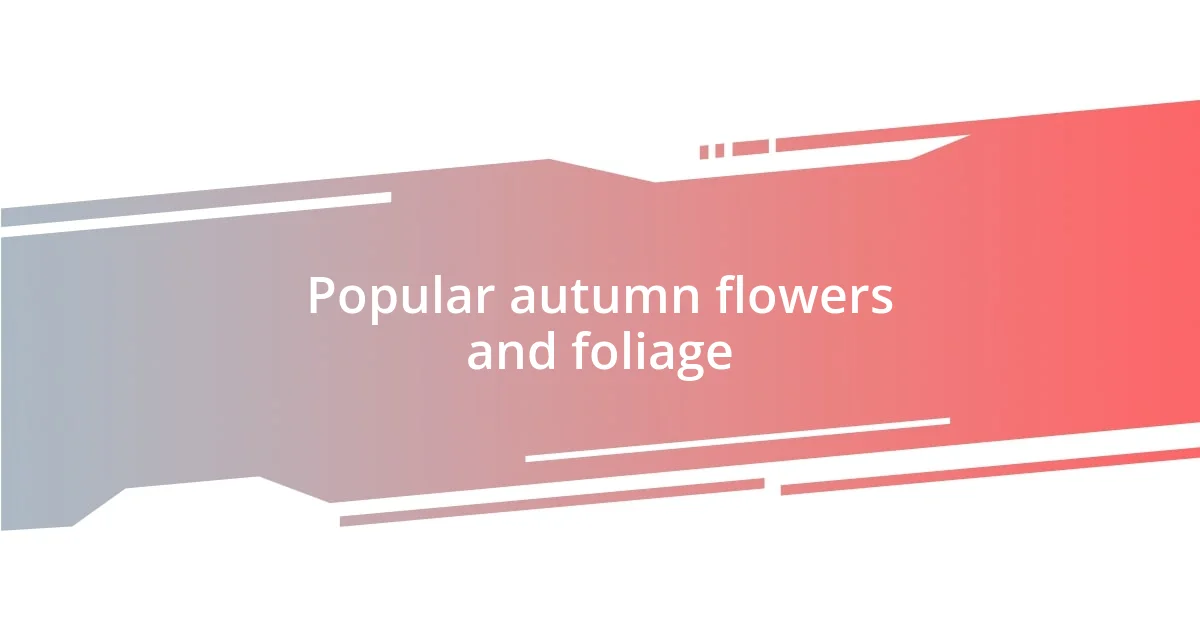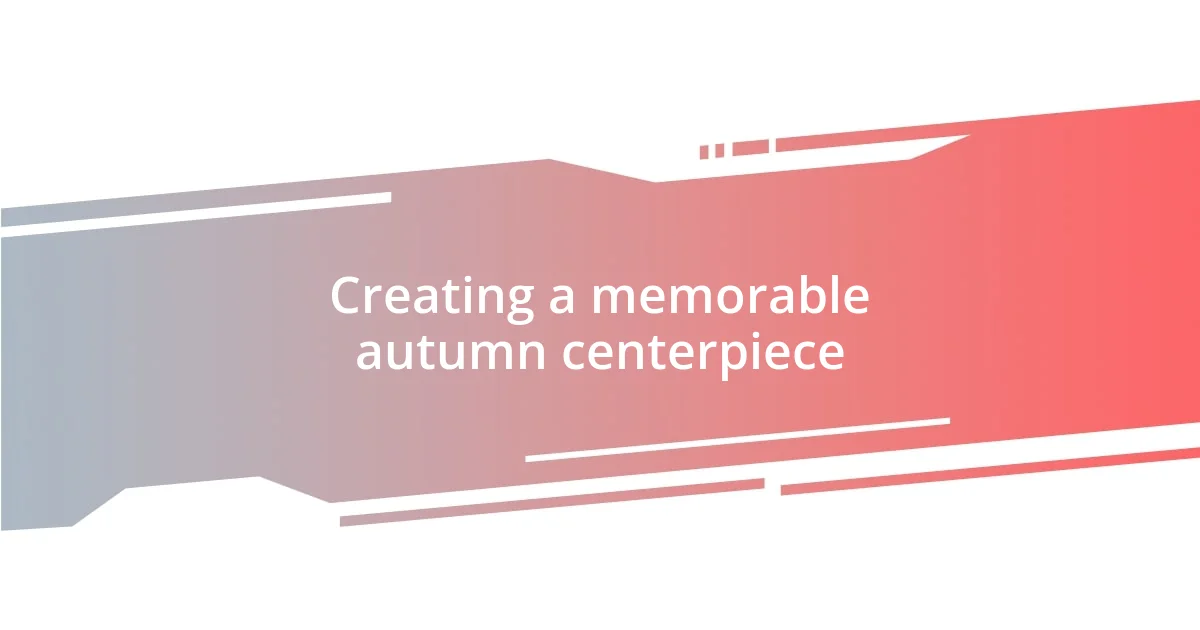Key takeaways:
- Autumn florals evoke strong emotions and nostalgia, inspiring creative arrangements that reflect the beauty and warmth of the season.
- Understanding seasonal palettes and color combinations is crucial for creating harmonious floral designs that resonate emotionally with viewers.
- Incorporating textures, varying heights, and fragrance enhances the sensory experience of arrangements, while proper maintenance extends the life of autumn flowers.

My passion for autumn florals
There’s something magical about autumn florals that truly captivates me. I remember walking through my local farmers’ market last fall and being enchanted by the vibrant hues of burnt orange and deep burgundy chrysanthemums. The richness of these colors not only brightened my day but also inspired me to create arrangements that mirror the beauty of the changing seasons.
My passion for autumn blooms goes beyond mere aesthetics; it’s about the emotions they evoke. Whenever I see a bouquet filled with sunflowers and dahlias, I can’t help but feel a rush of nostalgia, reminiscent of cozy gatherings with loved ones around harvest tables. Have you ever experienced that comforting warmth from something so simple as a flower? I find that these blooms have the power to bridge memories and feelings, creating an emotional tapestry that ties us to the moment.
In my floral designs, I strive to capture the essence of autumn’s fleeting beauty. I often find myself experimenting with textures, layering dried leaves and berries with fresh flowers to evoke that crisp, invigorating fall air. Each arrangement becomes a reflection of my enthusiasm, allowing me to transform a simple space into a celebration of the season’s splendor.

Understanding seasonal flower palettes
Understanding seasonal flower palettes is essential for any floral designer, especially during autumn when nature provides a stunning array of colors and textures. I often find myself enthralled by the deep, warm tones that define this season. It’s fascinating how flowers like asters and marigolds complement each other, creating a harmonious blend that reflects the autumn landscape.
When selecting flowers, it’s not just about the colors, but also about the feelings they evoke. I remember crafting an arrangement with rich golden sunflowers, paired with the moody purple of lilacs. The combination felt like a warm hug, capturing the essence of early evening sunsets. This emotional connection to the flowers helps to inform my choices, ensuring each bouquet resonates with the viewer.
Consider how different flowers bring distinct vibes to your design. For instance, while the fiery hues of zinnias shout excitement, softer shades of roses introduce tranquility. This balance can transform a simple arrangement into a powerful statement piece, making it vital to understand how seasonal palettes interact and evolve.
| Flower Type | Typical Colors |
|---|---|
| Asters | Deep purples, blues |
| Marigolds | Vibrant oranges, yellows |
| Sunflowers | Bright yellows, browns |
| Dahlias | Rich reds, burgundies |
| Roses | Soft pinks, whites |

Choosing colors for autumn designs
Choosing colors for autumn floral designs is one of my favorite parts of the creative process. I genuinely believe that autumn’s palette is unmatched—think about those stunning ambers, russets, and ochres that reflect the rich tapestry of nature. My heart sings when I pair vivid oranges with dusky greens. I remember a particular arrangement I created last year for a friend’s fall wedding. The deep, wine-colored dahlias mixed with gold-toned foliage created an intoxicating atmosphere, reminiscent of the celebration itself and the warmth of shared moments.
To help guide your color choices in autumn designs, consider the following:
- Warm hues like burnt orange and mustard yellow evoke feelings of comfort.
- Deep reds and burgundies add an element of sophistication and richness.
- Soft neutrals, such as taupe and cream, can balance bolder colors and introduce a calming element.
- Dark greens serve as a grounding backdrop that highlights the vibrancy of other colors.
- Pops of purple from flowers like asters can introduce a touch of unexpected elegance to your arrangements.
By thoughtfully combining these colors, you can curate a floral display that not only looks stunning but also resonates emotionally with everyone who experiences it.

Popular autumn flowers and foliage
When it comes to autumn flowers, I can’t help but think of the stunning dahlias with their bold, intricate blooms. I once put together a centerpiece for a friend’s dinner party using vibrant burgundy and orange dahlias. It created such a feeling of warmth and richness that guests couldn’t resist commenting on it all evening. Isn’t it interesting how a few carefully chosen flowers can transform a space and elevate the mood?
Then, there are sunflowers, those cheerful beacons of light amidst the autumn hues. I vividly remember a fall market visit where I stood captivated by a stand overflowing with sunflowers, their yellows and browns mirroring the golden leaves around me. The sheer joy they bring is infectious, isn’t it? Pairing them with soft greens or even lavender can create a wonderfully balanced arrangement that feels both lively and serene.
Let’s not forget foliage, which is just as significant in autumn arrangements. I often incorporate branches of vibrant red and orange maple leaves into my designs. One time, I combined these with creamy white roses for a wedding. The dynamic contrast was breathtaking and truly highlighted the romantic essence of the season. Don’t you think foliage can change the entire character of a floral design? By thoughtfully selecting both flowers and greenery, I believe we can capture the very spirit of autumn in every arrangement.

Techniques for autumn floral arrangements
When arranging autumn floral designs, I find that texture plays a crucial role in creating depth and interest. In one of my arrangements, I mixed soft, feathery grasses with fir branches and dense, velvety petals—this combination not only looked beautiful but also added a delightful tactile experience. Isn’t it satisfying when a floral piece invites you to reach out and touch it, to explore the contrast between the softness of a flower and the ruggedness of a branch?
Another technique I love is using varying heights to create a dynamic composition. I often use tall, sturdy flowers, like delphiniums or statice, to anchor an arrangement, and then I add cascading elements like ivy or trailing amaranth. This layering not only draws the eye upward but also mimics the natural landscapes of autumn where tall trees stand proudly against a backdrop of falling leaves. Have you noticed how those captivating lines can lead you through an arrangement, evoking a journey through a forest in fall?
Lastly, I swear by the power of fragrance in autumn designs. When I first introduced cinnamon-scented chrysanthemums into one of my centerpieces, the aromatherapy aspect transformed the atmosphere entirely. Guests commented on how the scent brought nostalgic memories of cozy evenings by the fireplace. Isn’t it amazing how a single aromatic flower can transport us to a different time and place? Blending fragrance with visual beauty, I believe, elevates the entire sensory experience of autumn floral arrangements.

Tips for maintaining autumn flowers
To ensure your autumn flowers maintain their beauty throughout the season, keep them in fresh, clean water. I remember the first time I used crisp yellow chrysanthemums; they wilted within a day because I hadn’t changed the water. It’s incredible how something so simple can make such a difference. Regularly trimming the stems at an angle can also enhance water absorption, breathing new life into your arrangements.
Another tip I swear by is to avoid placing your autumn flowers in direct sunlight or near heating vents. I learned this the hard way when my lovely vase of mixed autumn blooms quickly drooped under the afternoon sun. Now, I choose cozy corners in my home where soft, indirect light can illuminate the flowers without stressing them out. Isn’t it fascinating how a change in environment can extend their life?
Lastly, I recommend paying attention to any wilting or browning leaves. Whenever I spot a tired leaf, I gently remove it, understanding that it’s crucial for the overall health of the arrangement. It’s a small act, but it reminds me of how caring for these beautiful blooms is like nurturing a relationship. Every little effort counts, doesn’t it?

Creating a memorable autumn centerpiece
Creating a memorable autumn centerpiece involves selecting the right combination of colors and natural elements to evoke that cozy, seasonal feeling. I remember a particular centerpiece where I used deep oranges, rich burgundies, and earthy greens to reflect the changing leaves outside. As I arranged the flowers, I kept asking myself: how can I make this not just visually striking but also an embodiment of autumn’s warmth? The answer lay in mixing diverse textures, from shiny apples to matte pumpkins, creating a rich tableau that sparked delightful conversations.
To make the centerpiece stand out, consider incorporating seasonal accents like branches or even mini pinecones. One year, I decided to weave twigs through my arrangement, and to my surprise, they transformed the entire look, grounding the flowers while enhancing the overall theme. It felt like bringing a piece of the outdoors inside—what better way to celebrate autumn than by showcasing its natural elements in a warm, inviting way? Isn’t it fascinating how something as simple as a twig can provide depth and authenticity to your design?
Lastly, don’t underestimate the importance of the setting for your centerpiece. I recall distinctly how lighting played a crucial role when I placed my arrangement near a flickering candle. The warm glow highlighted the colors and made the whole piece feel alive, inviting everyone to gather around it. Think about where you’ll display your creation; could it be on a rustic table set for dinner or anchored on a mantelpiece? The right backdrop not only enhances the beauty of your centerpiece but also fosters a warm atmosphere that encourages connection and enjoyment.















